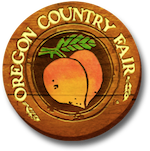OCF emphasizes fellowship, innovation, integrity, non-violence, and reverence for the land.
The site, on the banks of the meandering Long Tom River, has been used for seasonal gatherings for thousands of years, as indicated by the archaeological evidence of camas-roasting ovens and flint knapping. It is flooded several times most winters. The site includes wetlands and uplands, forests and prairies, endemic and introduced plant and animal species, wildlife habitat, camp sites, parking lots, roads, bridges, public paths, and work zones. Indian Creek crosses the property in a constructed channel. The former agricultural land on the property has been retired from active production for at least three decades.
The Oregon Country Fair, in accordance with our policies and philosophies as stewards of the land, vows to restore and manage our lands and waters for the purpose of protecting and preserving its natural wonders, significant fields, forests, wetlands, rivers and streams, with all of its wildlife, in a natural state for the education, pleasure and recreation of the public now and in the future. With this vision of stewardship, the site will be managed as a natural forest with its full cycle of birth, growth, senescence, and decay.
Purpose of Plan
This plan is meant to be used as a guideline for land management decisions at the Oregon Country Fair. Balance is necessary in its application. Reverence for the land, health and safety of OCF participants, and the success of the Fair require compromise and judgement. No rule can cover all possible contingencies, and evolving knowledge dictates that the plan must also evolve. Consult the OCF Site Manager or the Land Use Management Planning (LUMP) committee to determine how proposed developments can follow these guidelines.
The OCF Board of Directors established the Land Use and Management Planning committee (LUMP) in 1991 and charged its members with developing a comprehensive overview of the site and a plan for its management. The Board voted in 1998 to adopt land use planning as a guiding principle.
LUMP committee members and volunteers have included biologists, botanists, land use planners, builders, landscape architects, wetland delineators, and OCF participants from all parts of the Fair. The recommendations contained in this plan are distilled from extensive site monitoring, the advice of experts, and OCF tradition. Interested parties are urged to contact the LUMP committee to participate in the evolution of this plan. Our thanks to all those who have contributed.
Components of Plan
This document includes land use policies, implementation guidelines, subplans, a zone map, and zone descriptions. The different sections serve different needs. The following two sections (land use policies, implementation guidelines) list central, and concise, policies and implementation actions. The subplans include more detail on land use activities and site characteristics. The zone map and accompanying zone descriptions provide a geographical guide to land use. Where practical, the zone map and descriptions are cross-referenced to land use subplans.
Board Liaisons: Paxton Hoag and Jon Steinhart
Click here for the LUMP Committee website: https://lump.oregoncountryfair.org/ *
*External volunteer websites are not managed by the Oregon Country Fair.

 June-ly Board Meeting-June 25th – 4pm-6pm – Hybrid Meeting
June-ly Board Meeting-June 25th – 4pm-6pm – Hybrid Meeting